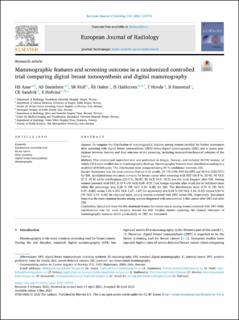| dc.contributor.author | Aase, Hildegunn Siv | |
| dc.contributor.author | Danielsen, Anders Skyrud | |
| dc.contributor.author | Hoff, Solveig Roth | |
| dc.contributor.author | Holen, Åsne Sørlien | |
| dc.contributor.author | Haldorsen, Ingfrid S. | |
| dc.contributor.author | Hovda, Tone | |
| dc.contributor.author | Hanestad, Berit | |
| dc.contributor.author | Sandvik, Cecilia Karolina | |
| dc.contributor.author | Hofvind, Solveig | |
| dc.date.accessioned | 2022-02-21T13:27:50Z | |
| dc.date.available | 2022-02-21T13:27:50Z | |
| dc.date.created | 2021-06-15T21:01:32Z | |
| dc.date.issued | 2021 | |
| dc.identifier.issn | 0720-048X | |
| dc.identifier.uri | https://hdl.handle.net/11250/2980557 | |
| dc.description.abstract | Purpose
To compare the distribution of mammographic features among women recalled for further assessment after screening with digital breast tomosynthesis (DBT) versus digital mammography (DM), and to assess associations between features and final outcome of the screening, including immunohistochemical subtypes of the tumour.
Methods
This randomized controlled trial was performed in Bergen, Norway, and included 28,749 women, of which 1015 were recalled due to mammographic findings. Mammographic features were classified according to a modified BI-RADS-scale. The distribution were compared using 95 % confidence intervals (CI).
Results
Asymmetry was the most common feature of all recalls, 24.3 % (108/444) for DBT and 38.9 % (222/571) for DM. Spiculated mass was most common for breast cancer after screening with DBT (36.8 %, 35/95, 95 %CI: 27.2−47.4) while calcifications (23.0 %, 20/87, 95 %CI: 14.6−33.2) was the most frequent after DM. Among women screened with DBT, 0.13 % (95 %CI: 0.08−0.21) had benign outcome after recall due to indistinct mass while the percentage was 0.28 % (95 %CI: 0.20−0.38) for DM. The distributions were 0.70 % (95 %CI: 0.57−0.85) versus 1.46 % (95 %CI: 1.27−1.67) for asymmetry and 0.24 % (95 %CI: 0.16−0.33) versus 0.54 % (95 %CI: 0.43−0.68) for obscured mass, among women screened with DBT versus DM, respectively. Spiculated mass was the most common feature among women diagnosed with non-luminal A-like cancer after DBT and after DM.
Conclusions
Spiculated mass was the dominant feature for breast cancer among women screened with DBT while calcifications was the most frequent feature for DM. Further studies exploring the clinical relevance of mammographic features visible particularly on DBT are warranted. | en_US |
| dc.language.iso | eng | en_US |
| dc.publisher | Elsevier | en_US |
| dc.rights | Navngivelse 4.0 Internasjonal | * |
| dc.rights.uri | http://creativecommons.org/licenses/by/4.0/deed.no | * |
| dc.title | Mammographic features and screening outcome in a randomized controlled trial comparing digital breast tomosynthesis and digital mammography | en_US |
| dc.type | Journal article | en_US |
| dc.type | Peer reviewed | en_US |
| dc.description.version | publishedVersion | en_US |
| dc.rights.holder | Copyright 2022 The Authors | en_US |
| dc.source.articlenumber | 109753 | en_US |
| cristin.ispublished | true | |
| cristin.fulltext | original | |
| cristin.qualitycode | 1 | |
| dc.identifier.doi | 10.1016/j.ejrad.2021.109753 | |
| dc.identifier.cristin | 1915991 | |
| dc.source.journal | European Journal of Radiology | en_US |
| dc.identifier.citation | European Journal of Radiology. 2021, 141, 109753. | en_US |
| dc.source.volume | 141 | en_US |

